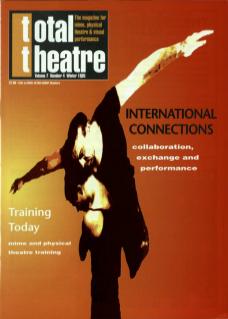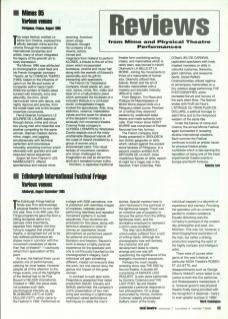The Edinburgh Festival Fringe finally saw fit to acknowledge physical theatre in its own right this year. Now in its 49th year, the Fringe programme gave the form a billing alongside dance but, perhaps more importantly, separate from theatre. Are they trying to suggest that physical theatre, a recognised but yet to be fully defined performance art, shares more in common with the movement vocabulary of dance than that of theatre? – I cautiously refrain from speculation at this point.
As ever, the festival threw up an eclectic mix of performances, catering for most tastes. However, despite all of this attention to the fringe events, one of the highlights of the festival had to be Pina Bausch's Nelken (Carnations). Created in 1982, the piece does not possess such dark, psychological intensity as, say, Bluebeard (1977) or Cafe Muller (1977), which came to the Festival in 1992. Performed on a stage with 2000 carnations, one is presented with relentless images of hopeless, helpless people performing relentless and repeated movement patterns in surreal sequences. Four stuntmen are employed for this piece, along with ferocious Alsatians in order to convey an oppressive, brutal atmosphere as performers search for personal and emotional liberation and freedom. Bausch's work is always a highly personal experience for the spectator and one is continuously haunted by the choreographer's imagery. Each individual will gain something different, indeed not everyone likes the work, but one cannot deny the genius and impact of this great woman.
In contrast to such epic work, Peepolykus presented their latest production Squid. Cleverly and skilfully performed, the company's comic presentation of two men living and working in a lighthouse employed varied performance techniques to relate the men's stories. Special mention here to John Nicholson's fine portrayal of the lighthouse keeper. There was an inventive use of puppetry to remove the action from the stifling lighthouse room, and the acrobatics employed to represent a storm were excellent.
This Way Up's Burnout unfortunately suffered from a lack of writing clarity. Although the choreography was well devised, the character and plot development failed to clearly emerge and one was left questioning the significance of the energetic movement sequences.
Perhaps the most visually arresting show was The End by fecund theatre. A double-bill comprised of Kafka’s Last Request (a solo piece performed by Dominic Coleman) and The Last Poet, fecund theatre presented a personal response to two philosophers. On a stage surrounded by mirrors, Dominic Coleman adeptly physicalised Kafka's vision of the lonely individual trapped in a labyrinth of experience and memory, providing the spectator with an unnerving parallel to modern existence. Equally disturbing was the company's portrayal of the modern day philosopher and poet, Jim Morrison. This was not, however, a direct biographical exploration of the man, but rather a striking production exploring the spirit of the highly complex and intelligent artist.
There were of course other gems at this year's festival, in particular Nada Théâtre's Romeo et Juliette, and disappointments such as George Dillon's Hamlet which failed to do justice to both this fine performer and Shakespeare's masterpiece. It is, however, good to see physical theatre finally being provided with the recognition it deserves – here's to even greater success in 1996!

